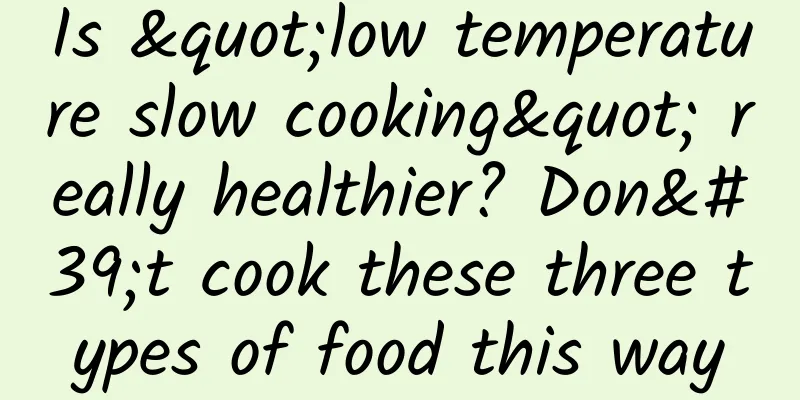Is "low temperature slow cooking" really healthier? Don't cook these three types of food this way

|
Compared with traditional cooking methods, some of you may have heard of "low-temperature slow cooking" - ensuring that the cooking temperature of food is between 50 and 80°C, which sounds healthier. There is a type of "low temperature slow cooker" that sells well online. What is this cooking method like? Is it really healthier? Is it necessary to buy a "low temperature slow cooker" for daily cooking? Low temperature slow cooker from e-commerce platform Let me first state the conclusion : Compared with traditional high-temperature cooking, "low-temperature slow cooking" is indeed a healthier choice. It can minimize water loss, keep the original flavor of food, protect the protein and vitamins in food, and lock in more nutrients. But its shortcomings cannot be ignored. In particular, it should be noted that there are three types of food that are not recommended to be slow cooked at low temperature . As for the "low temperature slow cooker", it is recommended to carefully consider the frequency of use and purchase with caution. Origin and history of “low temperature slow cooking” First of all, the so-called "low temperature slow cooking" is not a novel cooking method. Don't place an order just because you think it is high-tech. This cooking method is also called "vacuum low temperature cooking". In essence, the ingredients are sealed in a soft, high temperature resistant plastic bag before cooking, and the bag is vacuumed to remove the air. Then the food is cooked in a water bath pot, a multipurpose steam oven, or other heating system that allows precise temperature adjustment. The temperature is generally between 50℃ and 80℃, and the cooking time is as long as several hours or even more than ten hours or more. This method has been in its infancy since the 1960s. In the 1960s, NASA encountered difficulties in providing food for astronauts. It was difficult to store food in bottles and cans in spacecraft, so they tried to use high-temperature plastic bags to store food, which was the initial exploration of a cooking method similar to "sous vide cooking". At the same time, a hospital in Sweden was also trying to immediately seal the traditionally prepared still hot food in a plastic bag, and then continue to cook for 3 to 10 minutes, and then cool it down. In this way, at least 5 million meals were provided to patients, which was close to "sous vide cooking". Low temperature slow cooking method from wiki Also in the 1960s, Ambrose T. McGuckian invented a new method to vacuum seal unprocessed ingredients and then cook them by controlling the appropriate time and temperature. This was called "sous-vide cooking" and was also intended to improve the quality of hospital food. Later, McGuckian, as a hotel technical consultant, used this method in the food supply of his hotel. In the early 1970s, George Puarus solved the problem of loss of liquid and fat during the cooking process of foie gras in clay pot by "sous-vide low-temperature cooking", reducing the loss rate of foie gras from 40% to 5%. This incident also led to his cooperation with Cryovac, which eventually produced multi-layer high-temperature resistant plastics to preserve more juice when cooking. George Puarus is also known as the "father of sous vide cooking". In the late 1970s, "sous vide cooking" began to be used in British and French aviation and railway systems to provide passengers with a better dining experience. Later, "vacuum low-temperature cooking" has been developing slowly, and many home appliance manufacturers have also developed equipment suitable for commercial or home use. Now many of them are packaged as "low-temperature slow cooking". From the development history and application scenarios, low-temperature slow cooking focuses on deliciousness and convenience. So should we buy such kitchenware products? Let's understand its advantages and disadvantages before making a decision. Advantages of slow cooking There are many advantages to slow cooking, including the following: Avoid the production of harmful substances: The low-temperature slow cooking temperature is generally only 50℃ to 80℃, so there is no need to worry about the production of carcinogens; there is also almost no cooking fume, which not only reduces the risk of cancer, but also avoids the impact of fume on respiratory health. When we fry fish or steak, when the food is gradually heated, when the center of the food is cooked, the outer layer of the meat will inevitably be overcooked, causing the meat to become dry, nutrients to be lost, and even carcinogens to be produced. Low-temperature slow cooking can solve this problem. Frying, stir-frying and deep-frying fumes are inevitable. Please do not reprint without authorization. Less worry when cooking: Low-temperature slow cooking can be "set on time", so you don't have to worry about controlling the heat, and it is difficult to burn or scorch the pot due to carelessness. Cooking overtime will not seriously affect the quality of the food. It is very suitable for friends who don't have time to study cooking. For example, it is difficult to fail to make hot spring eggs or steaks using low-temperature slow cooking. And low-temperature slow cooking is stable enough to ensure the consistency of taste. Food tastes more tender and juicy: Current technology can accurately control the temperature and time of slow cooking at low temperature, so that the food is heated evenly and each part can reach the same temperature, thus achieving the effect that is almost impossible to achieve with traditional cooking methods, especially when cooking large pieces of meat. For example, a steak cooked at low temperature and slow cooking can be tender and melt in the mouth. Beef slow cooked at 60℃ for 4 hours can not only reduce the nutritional loss of steaming, but also improve the soft and dry state of high-temperature processed beef to a certain extent and improve the taste. Slow cooking at low temperature can also improve the problems of dry chicken breast, poor taste, and large loss of nutrients, and give chicken better water holding capacity. Others have studied the effect of slow cooking at low temperature on the quality characteristics of scallop muscle and found that the sensory quality of scallops is best when cooked at 70 and 75℃ for 30 minutes, and the juice loss rate is small. Better food preservation: Low temperature and slow cooking can also be used to preserve food. Food preserved in this way is less likely to lose flavor and texture after reheating (now you know why it was used in hospitals, railways, aviation and other fields in the first place). With ordinary preservation methods, oxidation of fish fat will give a fishy smell; oxidation of myoglobin in bright red meat will turn brown; and oxidation of fruit slices to brown, but low temperature and slow cooking can avoid all of this. This is because vacuum packaging avoids chemical reactions caused by contact between oxygen and food. And because it is sealed with a plastic bag, cross contamination between foods can be avoided during storage, ensuring food safety. Direct freezing has some disadvantages. Please do not reprint with permission from the copyright library. Foods that are frozen after slow cooking at low temperatures also have obvious advantages over directly freezing. Frozen storage after slow cooking at low temperatures can better prevent the growth of bacteria, and prevent the loss of food juices and the evaporation of volatile substances as much as possible, and can also prevent food from oxidative rancidity during frozen storage. Not only that, it can also extend the shelf life of food. Some researchers have found that chicken leg samples that were cooked at 75°C for 6 hours were stored in the refrigerator (3°C) and at room temperature (20°C). Although the total number of colonies, lactic acid bacteria, and Bacillus cereus increased with the extension of storage time, the storage period under refrigeration conditions can exceed 25 days, which is already very long, breaking the time limit for conventional refrigerated storage of chicken legs. Some people also believe that slow cooking at low temperatures can reduce the loss of nutrients in food, but this cannot be generalized. Although slow cooking at low temperatures does have a low temperature and can better preserve the "original flavor" , the loss of nutrients is also related to the length of heating time. Some nutrients, especially vitamins , may be lost more in a heating process that lasts for several hours than in a quick stir-fry over a few seconds. Disadvantages of slow cooking Although low-temperature slow cooking has a lot of halos, it also has disadvantages. 1 Long cooking time As the name "low temperature slow cooking" suggests, it is really slow! Usually, frying or boiling chicken breast only takes 10 to 15 minutes, but if you use "low temperature slow cooking", it may take 2 hours, which is very inconvenient for office workers whose time is precious. 2 High requirements for equipment It needs to meet the three elements of vacuum + low temperature + slow cooking. This means that you need to prepare vacuum sealing equipment, precision low temperature slow cooking equipment, and a container for water. Good machines are not cheap and take up a lot of space when stored. 3 May cause food poisoning If you are not familiar with the low-temperature slow cooking technology, the food may not be heated enough and the viruses and bacteria may not be completely killed. In addition, because low-temperature slow cooking involves a vacuuming step, cleaning the vacuum machine is also a problem. These three types of food are not recommended for low temperature slow cooking 1. Fungi : Many fungi are toxic and difficult to destroy in a low-temperature, slow-cooking environment. 2. Beans : such as beans, green beans, red kidney beans, soy milk, etc. They contain plant hemagglutinins or saponins, which will have a strong irritating effect on the gastric mucosa, and will also damage and hemolyze cells. They are toxic to a certain extent. If you want to eat them safely, you need to heat them at 100℃ for several minutes or even more than half an hour. 3. Meat with connective tissue : Generally speaking, the belly meat under the animal ribs is rich in connective tissue, such as the bubble-shaped breast meat used for making oil. Connective tissue cannot be decomposed at low temperatures and needs to be processed at high temperatures before it can be eaten. In summary, we cannot simply say that low-temperature slow cooking is a waste of money. This cooking method does have many advantages, including better flavor, longer shelf life, and is very advantageous for processing large pieces of meat or seafood. However, this cooking method requires high equipment, the process is not simple, and it takes a very long time. There are also limitations on the ingredients that are suitable for processing. Therefore, for those of us who are used to Chinese food, low-temperature slow cooking may not appear very often. It may not be suitable for people who lead busy daily lives, so everyone needs to think twice before buying. References [1] Modernist Cooking Translation Team. Modernist Cooking: The Art and Science of Cooking Volume 1: History and Foundations [M]. Beijing: Beijing Fine Arts and Photography Publishing House, September 2016. [2] Liu Xinrui, Kong Baohua, Xia Xiufang, et al. Research progress on the effects of low-temperature slow cooking on the edible quality and shelf life of meat products[J]. Meat Research, 2022, 36(12): [3] Liu Xinrui, Wang Meijuan, Ji Yunlong, et al. Effect of low-temperature slow cooking time on the quality and digestibility of ready-to-eat chicken breast [J/OL]. Food Industry Science and Technology: 1-13 [2023-11-07]. https://doi.org/10.13386/j.issn1002-0306.2023040104. [4] Jiang Shanshan, Diao Zhijie, Jiang Huili, et al. Effects of low-temperature vacuum cooking on the muscle quality characteristics of half-shell scallops [J/OL]. Food Industry Science and Technology: 1-15 [2023-11-07]. https://doi.org/10.13386/j.issn1002-0306.2023040148. [5] Li Mengqi. Study on the influence of vacuum low temperature cooking process on the quality and safety of chicken thigh meat[D]. Yantai University, 2019. Planning and production This article is a work of Science Popularization China-Starry Sky Project Produced by: Science Popularization Department of China Association for Science and Technology Producer|China Science and Technology Press Co., Ltd., Beijing Zhongke Xinghe Culture Media Co., Ltd. Author | Xue Qingxin, registered dietitian Reviewer: Ruan Guangfeng, Director of Science and Technology Department, Kexin Food and Nutrition Information Exchange Center Planning | Ding Zong Editor: Ding Zong |
<<: Pilots' anti-gravity suits were learned from giraffes?
Recommend
The era of subtitle groups has ended, but American dramas can't stop
Last weekend, Renren Video and Shooter Network, w...
Dadong Short Video Local Account Tutorial, including building ideas, layout production, copywriting content, editing operations, etc.
Dadong Short Video Local Account Tutorial, includ...
When influenza A strikes, doing this right is more effective than grabbing oseltamivir
Audit expert: Gu Haitong Deputy Chief Physician, ...
Summary of special events in major Android markets in March (registration in progress)
Millet [March traffic event] Registration is open...
How to promote brands on Bilibili | 6000-word strategy analysis
This article mainly aims to solve two problems: 1...
More than 70% of flashers prefer the pure version of the system
The mobile phone flashing market, which has exist...
Pollen and catkins season, these drugs are more life-saving than loratadine
【Appendix】Tips for using loratadine 1. Although l...
An introduction to Tencent WIFI Manager advertising promotion and material specifications!
1. WIFI Manager link animation advertisement Stro...
Is the high-priced "baby water" really healthy or a "tax on IQ"? The secret is revealed for you →
Those who have children at home may find that the...
Why do we become more irritable towards people we are closest to? The truth behind this is…
This article was reviewed by Dr. Tao Ning, Associ...
How to write copy without any flaws? Here are 4 practical tips
How do top writers treat their writing? Hemingway...
iOS componentization solution (Part 2)
Overview This is the second article of iOS compon...
Cold Dew: Do you listen to the "Autumn Johns Song" or follow the "Autumn Freeze" principle?
There is a proverb that goes, "After eating ...
Jack Trading Academy JTA: BangJack Practical Trading ING
Jack Trading Academy JTA: BangJack Practical Trad...









